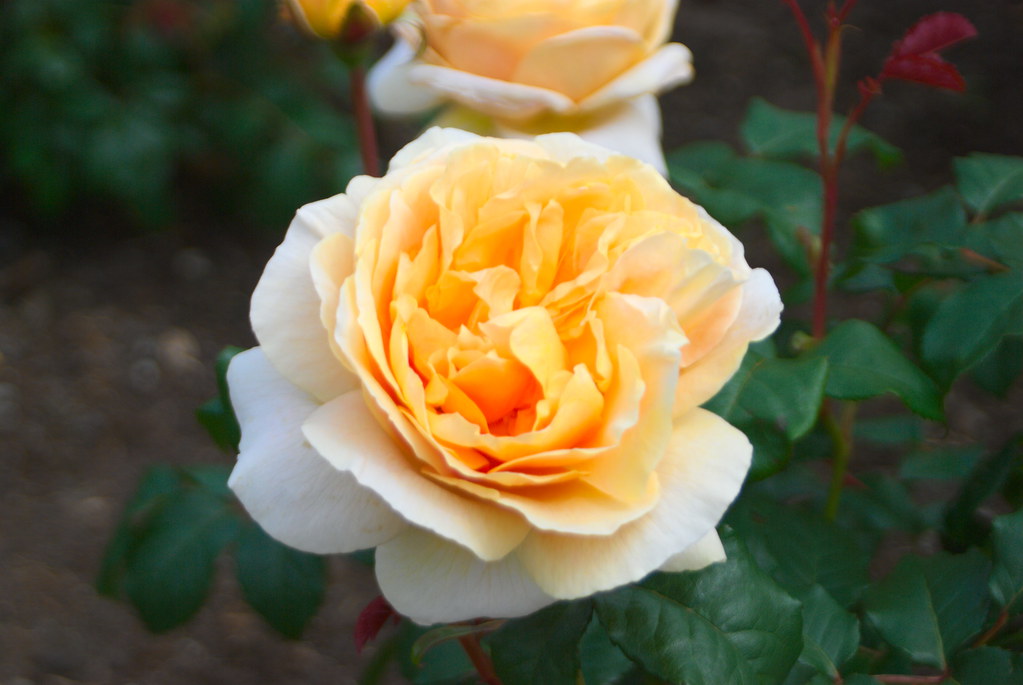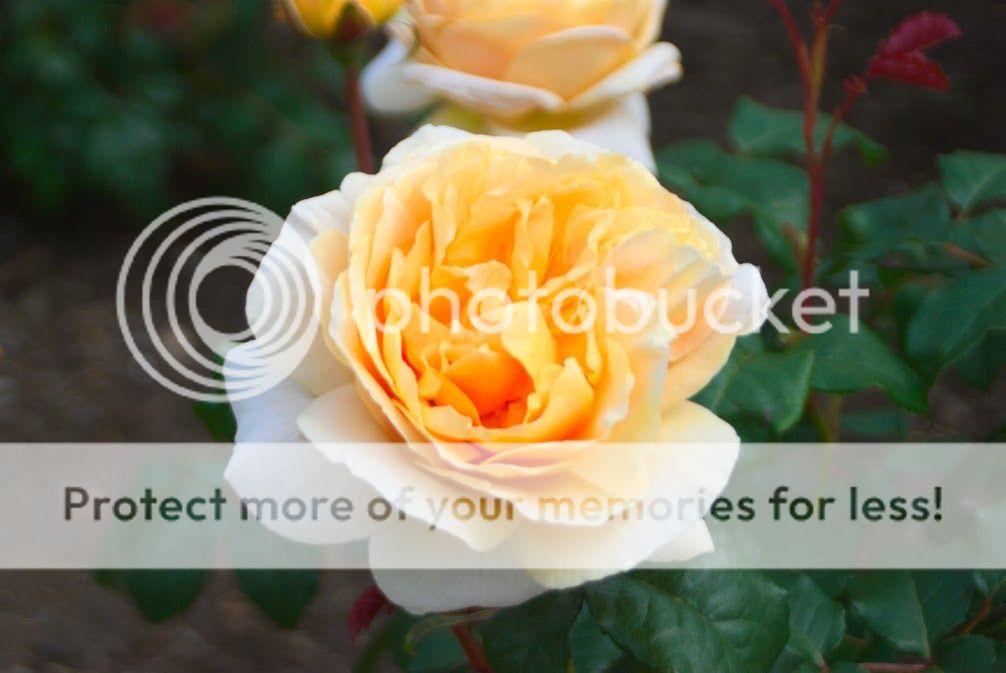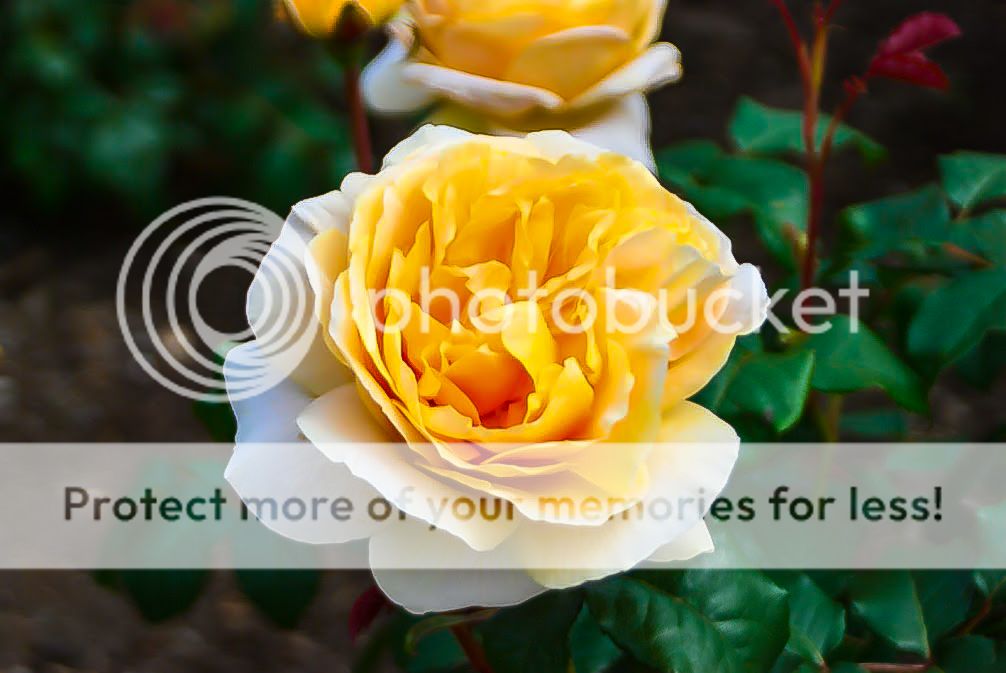I'll almost certainly need to get my head round post production as well.
No.. No you dont.
Photo of rose, as shot, is almost a Macro situation, ie 'close up'. With a 28-80 lens, your closest focus distance is likely quite long, as in perhaps three feet. f6 isn't a particularly 'wide' aperture, but it will be giving a fairly shallow Depth-of-Field at close range; what I 'see' in that photo is not softness, but a rather nice gradual focus fade away from the focus point out of the DoF zone.
You need to understand Depth of Field, and better understand 'focus' and not leave it to the cameras AF system....
Small irk of irony, when folk get into DSLR photo, the 'Go-Manual' mantra rears its ugly head, and every one.. yourself included, start getting all obsessed with the exposure settings... "f6.0 1/500s iso100".. because that is where they see a setting marked 'Manual' on the camera...and they see that, 'cos all the pro's go manual, don't they... and start obsessing over the hi/lo indicator exposure needle in the viewfinder, and pick aperture, shutter and ISO settings to make it center... good grief! How much faff to set the exact exposure the camera would have picked entirely automatically... and probably pick an utterly unsuitable aperture or shutter to effup the picture, instead of the exposure!
Manual Focus? Eh? Does NOT compute in today's modern menu minded, button obsessed psyce! Automatc exposure settings are only one 'thing' you can set manually on a camera; other, and actually far less accurate or reliable, than 'auto-exposure' systems is the 'Auto-Focus system! YET, hardly any-one turns that 'off', ad instead of being a slave to the swing eedle for exposure, are a slave to the 'red-dot' for focusing!!! Bizarre.
However... Depth of Field... how far infront and behind the point you focus the lens on, in the scene, is rendered in acceptably sharp focus.
On old manual focus lenses, we used to get quite useful DoF scales that put brackets around the focus distace t tell us, for any aperture setting the 'range' of acceptable focus we'd get.. some eve had 'stop down' or DoF preview buttns, to actually close the aperture iris so we could 'see' through the view fider the effect of different aperture settings on DoF... these days the aperture iris is electroncally controlled, and normally doesn't stop down to the taking aperture you set untl you fre the shutter, and you are lucky to get a proper focus distance scale, let alone DoF brackets on it.. but still!
Depth of Field, is a % of the focus distance; set by the aperture, A-N-D it's some-what proportional to the lens legth. So, the closer your subject, the less DoF you get; the wider your aperture (lower the f-No) the less DoF you get... if you use a longer lens, or zoom setting, you will tend to have to back away from the subject to get the same subject to frame scale, hence that will change the focus distance and the amount of DoF you get. but tryng to keep it simple.
On your rose; the subject isn't flat; the petals of the rose are almost vertical, and the camera could be trying to get a red-dot ANY where in the petal area, from the very tip closest to you in the middle, to the flat edge of the petal at the bottom almost poking out almost horezontal.
How tall is the rose flower? 2 inches? 5cm? And you were shooting at a range of what, less than 100cm? At f6, your DoF was likely only 10cm or so, front to back... one third infront of the focus point, two thirds behind.
If the camera red-dotted on the nearest bit of petal i the middle, then, 3cm of Dof infront was wasted, rendering 'nothing' in focus, and you oly had 6-7cm of the rose behid the front in the accetable focus range. If the Focus red-dotted on the petal poking out at the bottom; you would have had 3cm of focusinfront of that in the DoF zone, and earest tips in the middle are going 'soft', whilst 6-7cm of focus behind isn't resolving anythg, as there is othing there, until, what, aother two three inches, the leaves on the stem are showing.
Oh-Kay... working at close range; taking macro or almost macro type photo's; you are ealing wth critical focus dstances; A-N-D, if there s ay reason to 'Go-Maual' ths is a damn good one.. and NOT go 'manual exposure' but go 'Manual Focus'.
Switch the AF off, and focus manually, and if you dont have a DoF scale or brackets or 'preview' do it by Chimping, and fous on the front and then the back, and look at what you get at your preffered aperture, then pick something to put the DoF range around what you want to come ot i acceptable focus..
Ie rather than leavng it up to the red dot to try and work out whats a 'plane' it can get a bead on i teh scene, more, what plane it thnks you most likely want t to focus on in the scene; DIY! Look through the lens, and focus where YOU want to...
And on that rose, perhaps 5cm deep, and maybe 10cm of DoF would probably be best placed about 3-4cm into the head of the rose, so that the front petal tips ad the back petal blades are all just i that DoF zone of acceptable focus, and none of it is wasted.
Likely that there is absolutely NOTHING wrog with your lens.. easy to suggest a lens is a bit soft.. but far more common its the operator! Who, a slave to the rd-dots, will start moaning about focus softness and focus calibration, and gettig ever more absored in the gadgetry of the camera, blaming IT, for not dong what they probably cant! LOOK THROUGH THE LENS! FOCUS the lens on what YOU want to focus on, ot what red-dot guesses you might!
Oh-Kay.... Post-Process and digital 'sharpening... AHRGRAUMPHUGGERMYSTER!
No.. j-u-s-t NOoooooooo! Sorry GTG but this s just NOT a solution to this problem!
Mentioned earlier I have bee a post-process jocket, starting a conventonal dark-room for a very long time... it is pretty amazing what you may do in digital post-process these days, BUT, more remarkeable what you cant.... and ever have been.... and correcting effed up focus IS an absolute top of the list PRIMARY you must get it 'clean camera' No-No!
There is a trend boardering on obscession these days about 'sharpness'.. which can get a little cofuddling, as its hard to actually say what that actually IS.. and a lot of folk dont recognise that its a combination of factors, of which 'sharp focus' is actually but one element.
Small asside; small sensor cameras can delver an awful lot of 'aparent' sharpess. Reason is that small sensors ameras usually beg shorter focal length lenses, to give the same subject framing, and they tend to have very near close focus distaces; and the DoF zone as % of focus distance tends to be a far larger 'zone'.
Eg: I have a 4.5mm 'fish-eye' lens for my DSLR; the closest focus distance is something like 25cm, and infity focus is reached within 1.2m on the scale.. it's actually an auto-focus lens, but gawd knows why it needs it! Infinity focus is almost always withi the DoF zone, at pretty much all apertures, only really 'close' sujects are ever going to go a bit fuzzy, at the widest aperture, and by that I mea aythig less than a hads with from the front of the lens! At about f5 I think I ca put the front element actually touchg a subject and still have it in acceptable focus!
I also have a little action cam; that too has a 4.5mm focal length lens; has a TNY little sensor behind it, with an enormouse crop factor that gives that incredibly short focal length lens the equivilent field of view of a mild wide lens, maybe about 25mm or so o a Crop-Sensor camera, BUT it is still a 4.5mm lens, and gives the same icredible amount of DoF as the fish-eye... sensor is just croppng a very much more 'normal' angle of view from the middle of it!
For a action cam, which is primerily designed to shoot video, this s fatastic; the astoundng DoF the lens gives, effectively makes it 'focus free', everything from a few cm ifrot of the camera to finity, is pretty much always going to be in the DoF zone of acceptable focus so o need to have a fancy focus mechanism to adjust it.
AND everything is always rendered in incredibly 'sharp' focus.. thatks to the enormouse DoF of a very very short lens, and the crop factor.
Pretty similar principle is used by a lot of small-sensor cameras, from that little action cam, through phone-cams up to micro-sensor compact and bridge cameras, ie the common non-enthusiast 'consumer' cameras..And people are now accustomed to enormously 'sharp' focus photo's, with a awful lot of front to back Depth of Focus.... and so perceive that as a 'good' quality.
When they step up to larger sensor cameras, that beg longer lenses to get the same agle of view; the DoF starts to shink, and the DoF 'fade' fro the point of critical focus, through the DoF zone of 'acceptable-focus' into the distinctly 'out of focus' field, starts to become more obvious.
A-N-D, small curiosity, that to actually get more shallow DoF effects, folk oft start chasing fast, huge aperture primes to get it, and you get a quite bzare effect, where with a still relatively short focal length lens on a crop sensor DSLR, you need to use a very wide aperture to get a 'thin' DoF zone, and the rate of DoF fade out of that DoF zone can almost render the in-focus 'subject' so starkly against the distinctly 'out of focus' back-groud, that the sbjects often look as is they have been photo-shop 'merged' ito a scene, and were never actually a part of it; there is no visual conection between them, the DoF fade beig so sharp.
However... This more critical consideration of 'focus' and 'sharpness' is a perfectly 'natural' change brought about the step from micro-sensor cameras to crop-sensor DSLR's
And again probably absolutely NOTHING 'wrong' with your lens or your camera, and probably not a lot wrong with how you are using it.... EXCEPT that you don't understand DoF, and now using a larger sensor camera, where that IS something you have to consider and learn to exploit or work within, that the apparent sharpness and huge DoF provided by small sensor cameras, made pretty redundant; you NOW have to think about it...
NOT try and correct the ruddy thing in Photo-Shop!
First of all, you only need correct something thats a mistake! Uderstanding DoF ad crtcal focus, it may NOT be! Folk used to go to qute extreme measures to deliberatey achieve 'soft focus' for romantic fashion shots and stuff, usng 'soft focus' filters, or smearing UV filters with vasceline, or using 'centre spot' diffusers to 'diddle' the aparet focus fade ad sharpness around the subject... because 'soft focus' isn't ALWAYS 'bad'! Depends whether its an effect you wish to achieve or avoid!
And that starts NOT with trying to fudge it after the event in a photo-editor, BUT getting what you want, up front, at point of capture, 'Clean in Camera'.
Precedent of the Film-Only era, was that many photographers shot exclusively on slide. Few reasons for that; but significantly slide film, making a picture o the negative that was the artifact that would be viewed by the audience COULDN'T really be diddled or adjusted post process in any way.
Professionals, were often required to submit photos to picture desks on slide, because they would be assessed on prie merit of what was on the film. Yup, in commercial reprographics, if the picture was going to be used for a magazine spread, or bill-board or brochure, there would likely be post-process work done to it; BUT, closer the original image to what the editor wated, less work was needed to touch it up, correct it, and make it usable... IF it was even possible.
For all the fantastic features of a modern photo-editor, they still cant do an awful lot that couldn't be done in the dark room or reprographics studio fifty or more years ago; and they still cant correct basic primary mistakes LIKE pointing the camera at the wrong thing! Focusing on the wrong thing, or getting the exposure settings cockedup so that the subject is streaked across the frame, or half the scene is out of focus.
Old addage of the game is that you cant put in what was never there.. so shoot wide, make sure you get it all i, you can always crop it down later; get it focus at point of capture; you ight de-focus, a scene or portions of a scene or de-emphasise them with dodging ad burning post process, BUT you cant put n what was never there, OLY take away... So GET IT CEAN IN CAMERA... that should be your primary objective.
And just like the photo-desks of old; simple reason, IT SAVES WORK!
Get what you wat, clean i camera, hen you press the shutter, NO post-processing is required!
Another lamentable trend of modern photography IS the habitual compulsion to diddle i post process often simply because we can, and do it so easily, and having pt SO many easements into cameras to make it so easy to make a photo, to take away so much need to 'faff', and made it so unengaging to do.. it seems that camera-knob obsession, and post processing are a placebo to let folk 'feel' they are doing seething important and really getting 'involved' with this photo making lark!
BUT, poit is is is NOT necessary; before computers and the digital dark room, post-processing was something very very few even ore enthusiastic photographers engaged in, and most pro's actually strategically avoided! Time in the dark room, was tie they could be taking photo's and making money! Made no sense to spend any more time there than they absolutely had to.
As said, I am a dark-room 'jock'; was very early ito Digital Photo-Manipulation I do put far more time in there than I probably need or aught to diddling photo's in post; an awful lot of which are old flm photo's scanned to digital, I am often restoring... however.
Taking a 'set' on digital, its a absolute effoff ball-ache, mind numbing waste of time, to come back with perhaps 300 very similar shots, to sit there workig through them all, individully, messing wth sliders tweekng exposure or contrast or whatever, JUST because I have shot them all in Nikon's 'RAW' NEF format, so HAVE to open them in ViewNX to review them, and make a jpg 'display' copy that a prit, share or publish.. so WHILE I'M HERE... oh, I wonder if it would look tter wth a tad more saturation... Hmmm.. should I clone out that crisp packet... and so it goes on!
Its just NOT necessary! AND one of the reasons, as a rule I shoot JPG, not RAW! There is very very lttle added 'adjustment' you may make to a RAW file over a JPG, ad there is't a enorouse amount you can do to a JPG to turn a pigs ear into a silk purse!
Get it "Clean In Camera", at point of capture, and its pretty much redundant, you nailed it; you dont NEED to try correct or salvage the image. So WHY mess with it?




 flower
flower
